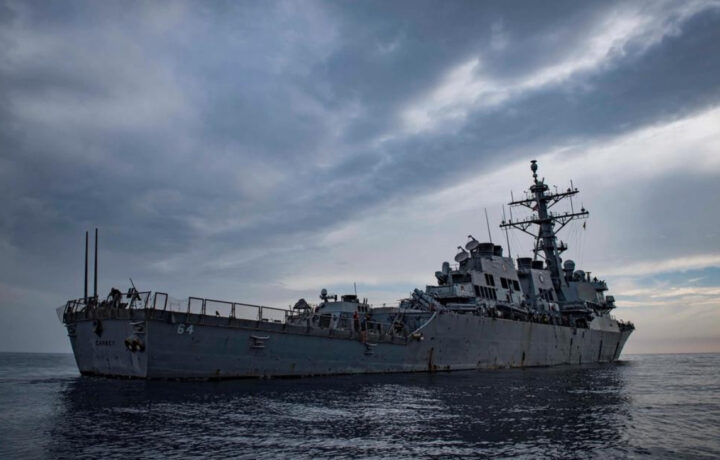The motto of the USS Carney (DDG-64) is “Resolute, Committed, Successful” – and after her recent deployment, the Arleigh Burke-class guided-missile destroyer and her crew has truly proven to be all three. The vessel returned to Mayport, FL, in May following a seven-month deployment to the Middle East.
DDG-64 was one of several U.S. Navy warships that endured what has been described as one of the most intense naval combat operations since the Second World War, countering missiles and drones launched by the Iranian-backed Houthi rebels in Yemen.
The vessel was rushed to the region following the October 7, 2023 terrorist attacks carried out by Hamas in Southern Israel – and was deployed to the Red Sea to protect commercial shipping that came under attack from the Houthis in support of Hamas. From nearly the moment USS Carney arrived in the Red Sea, it was engaged in combat operations.
In addition to protecting commercial ships, the guided-missile destroyer also helped shoot down cruise missiles and drones fired toward Israel.
“I think it was anywhere from 25 to 35 UAVs and land attack cruise missiles had been launched, and some of them were headed up the Red Sea,” Commander Jeremy Robertson, commanding officer of DDG-64, told CBS News. “We picked up the very first one-way attack UAV on our system approximately 60 or 70 miles away from us.”
Robertson added that USS Carney successfully downed the very first attack drone headed toward Israel, and the engagement went on to last nine hours as the destroyer launched a wave of air defense missiles to counter the Houthis. Not since the Second World War had the U.S. Navy been engaged in such an engagement.
It was also the first time that a U.S. vessel had to counter a supersonic missile, and in total USS Carney successfully shot down 45 out of 50 slow-flying drones and faster ballistic and cruise missiles.
Costly Exercise
Though the United States suffered no losses in the engagement with the Houthis, the monetary costs have been massive. The U.S. Navy was forced to fire hundreds, perhaps thousands of missiles costing more than a million dollars each to counter less costly missiles and even drones costing just thousands of dollars.
However, Robertson said he was never discouraged from using the right tools for the job.
“I’m entrusted with this $2 billion asset and 300-plus lives, and so the cost-benefit analysis to me shooting a missile is absolutely in my wheelhouse, and I’ll do it all day and twice on Sunday,” he added.
Combat-Proven Warship
Even before being deployed to the Red Sea last year, USS Carney had a proven combat track record and had previously conducted operations in the region – notably an anti-piracy mission in 2011.
Laid down in 1993 at the Bath Iron Works in Bath, ME, the warship was named for Admiral Robert Carney, who had served as Chief of Naval Operations during the Eisenhower administration – and perhaps fitting she was deployed alongside the U.S. Navy’s Nimitz-class nuclear-powered aircraft carrier USS Dwight D. Eisenhower (CVN-69) to defend the shipping lanes in the Red Sea and Gulf of Aden.
The guided-missile destroyer was launched in 1994 with Betty Taussig, Admiral Carney’s daughter, as the sponsor, and she was commissioned in April 1996.
USS Carney is equipped with two Mk 141 Harpoon anti-ship, one 29-cell and one 61-cell (90 total cells) Mk 41 vertical launching system (VLS) launchers. The VLS can be employed with a variety of surface-to-air missiles and the land-based Tomahawk cruise missile. The warship is also armed with a 127mm (5-inch)/54 Mk45 lightweight gun and a 20mm (0.8-inch) Phalanx close-in weapons system (CIWS).
Just six years after entering service, in early 2002, DDG-64 was deployed to the Mediterranean Sea and the Persian Gulf in support of Operation Enduring Freedom, the first stage of the War in Afghanistan and the larger-scale Global War on Terrorism.
In 2011, in support of Operation Ocean Shield in the Gulf of Aden, USS Carney disrupted four piracy attempts and disarmed and captured 30 suspected pirates. Five years later, she took part in Operation Odyssey Lightning, against ISIS militants in Libya.
For the vessel’s service, USS Carney has been awarded the U.S. Navy’s Combat Action Ribbon, multiple Navy Unit Commendations, the Navy Meritorious Unit Commendation, and the Navy E Ribbon. In addition, the guided-missile destroyer is a winner of the USS Arizona Memorial Trophy, which is awarded biennially to the ship, achieving the greatest combat readiness in strike warfare, surface fire support, and anti-surface warfare; and the Battenberg Cup is an award given annually as a symbol of operational excellence to the best ship or submarine in the United States Navy Atlantic Fleet.
Last week, Israeli Deputy Chief of the General Staff Maj. Gen. Amir Baram visited USS Carney with U.S. Navy Vice Adm. Brad Cooper, deputy commander of U.S. Central Command. The two leaders thanked the crew for their exceptional performance during their recent deployment to the Middle East.
“Each and every one of you plays a role in our joint fight against the forces of evil,” said Baram. “Our iron-clad cooperation is based on a shared set of values, deep friendship and trust. We’re not just allies, we’re friends.
“You have made history,” added Baram. “USS Carney was the first ship in the area to intercept land-attack cruise missiles and UAVs launched by the Houthis towards Israel.”




